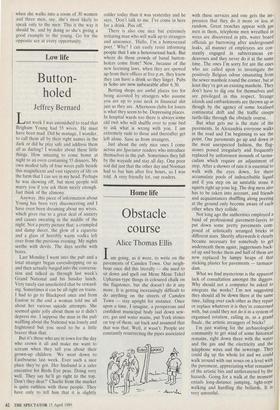Home life
Obstacle course
Alice Thomas Ellis
Iam going, as it were, to write on the pavements of Camden Town. Our neigh- bour once did this literally — she used to sit down and spell out Mene Mene Tekel Upharsin-type things in coloured chalk on the flagstones, but she doesn't do it any more. It is getting increasingly difficult to do anything on the streets of Camden Town — stay upright for instance. Once upon a time, I imagine, a prosperous and confident municipal body laid down sew- ers, gas and water mains, put York stones on top of them, sat back and assumed that that was that. Well, it wasn't. People are constantly resurrecting the pipes associated
with these services and one gets the im- pression that they do it more or less at random. Great trenches appear with gas men in them, telephone men wreathed in wires are discovered in pits, water board officials go burrowing after underground leaks, all manner of employees are con- stantly engaged in subterranean en- deavours and they never do it at the same time. The ones I'm sorry for are the ones who are called upon to investigate the positively Belgian odour emanating from the sewer manhole round the corner, but at least they've got an existing manhole. They don't have to dig one for themselves and are privileged in this respect. Strange islands and embankments are thrown up as though by the agency of some localised continental drift and the traffic creeps turtle-like through the obstacle course.
But what gets me is the state of the pavements. In Alexandria everyone walks in the road and I'm beginning to see the point. Our pavements go up and down in the most unexpected fashion, the flag- stones poised irregularly and frequently replaced by unforeseen mounds of tarma- cadam which require an adjustment of step. After a shower of rain it is essential to walk with the eyes down, for there accumulate pools of indescribable liquid and if you step on an unstable stone it squirts right up your leg. The dog mess also has to be taken into account, and friends and acquaintances shuffling along peering at the ground only become aware of each other when they collide.
Not long ago the authorities employed a band of professional pavement-layers to put down some pretty pavements com- posed of artistically arranged bricks in different sizes. Shortly afterwards it clearly became necessary for somebody to get underneath them again; juggernauts back- ed up and broke them and half of them are now replaced by lumpy heaps of that sticking plaster for pavements — tarmaca- dam.
What we find mysterious is the apparent lack of consultation amongst the diggers. Why should not a computer be asked to integrate the works? I'm not suggesting they should all be down there at the same time, falling over each other as they repair or replace whatever it is they're concerned with, but could they not do it in a system of organised rotation, calling in, as a grand finale, the artistic arrangers of bricks?
I'm just waiting for the archaeological community to get wind of some historical remains, right down there with the water and the gas and the electricity and the telephone wires and the sewerage. They could dig up the whole lot and we could walk around with our noses on a level with the pavement, appreciating what remained of the artistic bits and unthreatened by the hazards. Going for a walk at the moment entails long-distance jumping, tight-rope walking and hurdling the bollards. It Is very unrestful.


















































 Previous page
Previous page